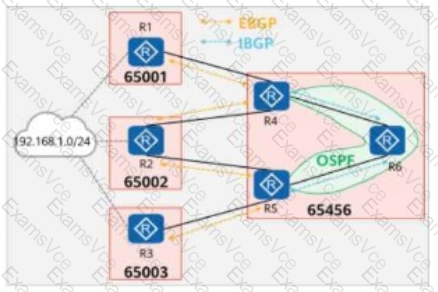Comprehensive and Detailed In-Depth Explanation:
Understanding the BGP and OSPF Network Topology in the Question:
External Route Importation
R1, R2, and R3 import 192.168.1.0/24 into BGP from an external source.
This means R1, R2, and R3 will advertise this route to their EBGP and iBGP peers.
BGP Route Selection Criteria
BGP follows specific rules to determine the best path for a route. The most relevant factors here are:
Highest Local Preference (LOCAL_PREF) → Preferred
Shortest AS Path → Preferred
Lowest Origin Type (IGP < EGP < Incomplete) → Preferred
Lowest MED (Multi-Exit Discriminator) → Preferred
Oldest eBGP route (if paths are equal) → Preferred
Route Selection Analysis for Each Statement:
A. For 192.168.1.0/24, R5 preferentially selects the route received from R2. ✅ (Correct)
R5 is in AS 65456 and peers with R6 using iBGP.
Since R2 is a central router with direct connectivity to R5, it is the most preferred path compared to indirect paths from R1 or R3.
By default, R5 will prefer the path from R2 over others unless explicitly influenced by BGP attributes.
✅ Statement A is correct.
B. For 192.168.1.0/24, R4 preferentially selects the route received from R1. ❌ (Incorrect)
R4 and R5 use Loopback0 to establish iBGP with R6, meaning they receive BGP routes from multiple sources.
BGP prefers the shortest AS path, and there is no specific information indicating that R1’s path is the shortest for R4.
R4 may actually prefer another router's advertisement (e.g., R2 or R3) depending on AS path length and other attributes.
❌ Statement B is incorrect.
C. For 192.168.1.0/24, if the default local-preference 150 command is configured on R3, R5 preferentially selects the route received from R3. ✅ (Correct)
By default, BGP assigns a local-preference of 100.
If R3 sets local-preference to 150, it is higher than other routes (R1, R2).
BGP prefers the highest local-preference value, so R5 will prefer the route received from R3 if this attribute is set.
✅ Statement C is correct.
D. For 192.168.1.0/24, R6 preferentially selects the route received from R4. ❌ (Incorrect)
R6 is an iBGP peer of both R4 and R5.
BGP best-path selection depends on attributes like local-preference, AS-path, and MED.
There is no explicit information suggesting that R4’s advertisement is preferred over R5’s.
R6 may prefer R5’s route depending on attributes.
❌ Statement D is incorrect.
Final Conclusion:
✅ A. R5 preferentially selects the route received from R2.❌ B. R4 does not necessarily prefer R1’s route.✅ C. If R3 sets local-preference 150, R5 will prefer the route from R3.❌ D. R6 does not necessarily prefer R4’s route.
Thus, the correct answers are: A, C.
[Reference:, HCIP-Datacom-Advanced Routing & Switching Technology V1.0 – BGP Route Selection and Local Preference, Huawei Official HCIP-Datacom Study Guide – BGP iBGP Peering and Best Path Selection Rules, Huawei Documentation on BGP Local-Preference and Route Selection Behavior, , , ]




